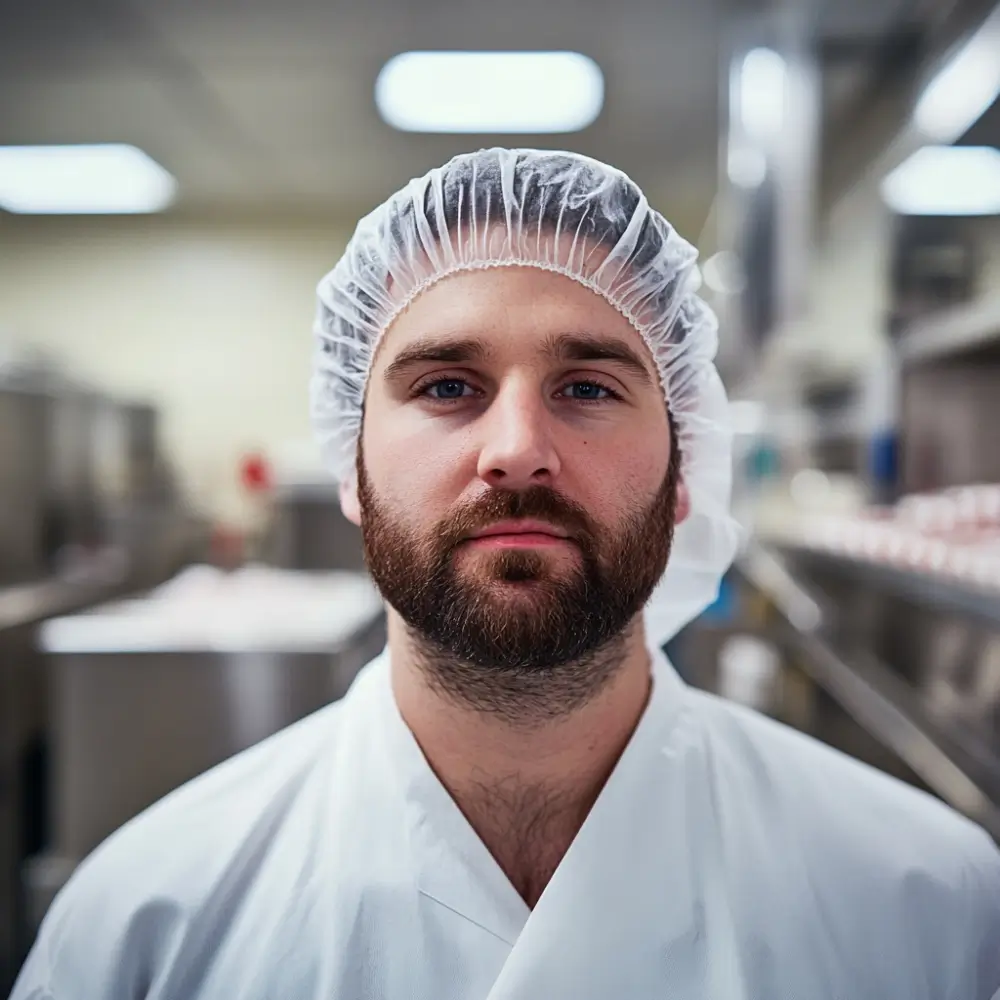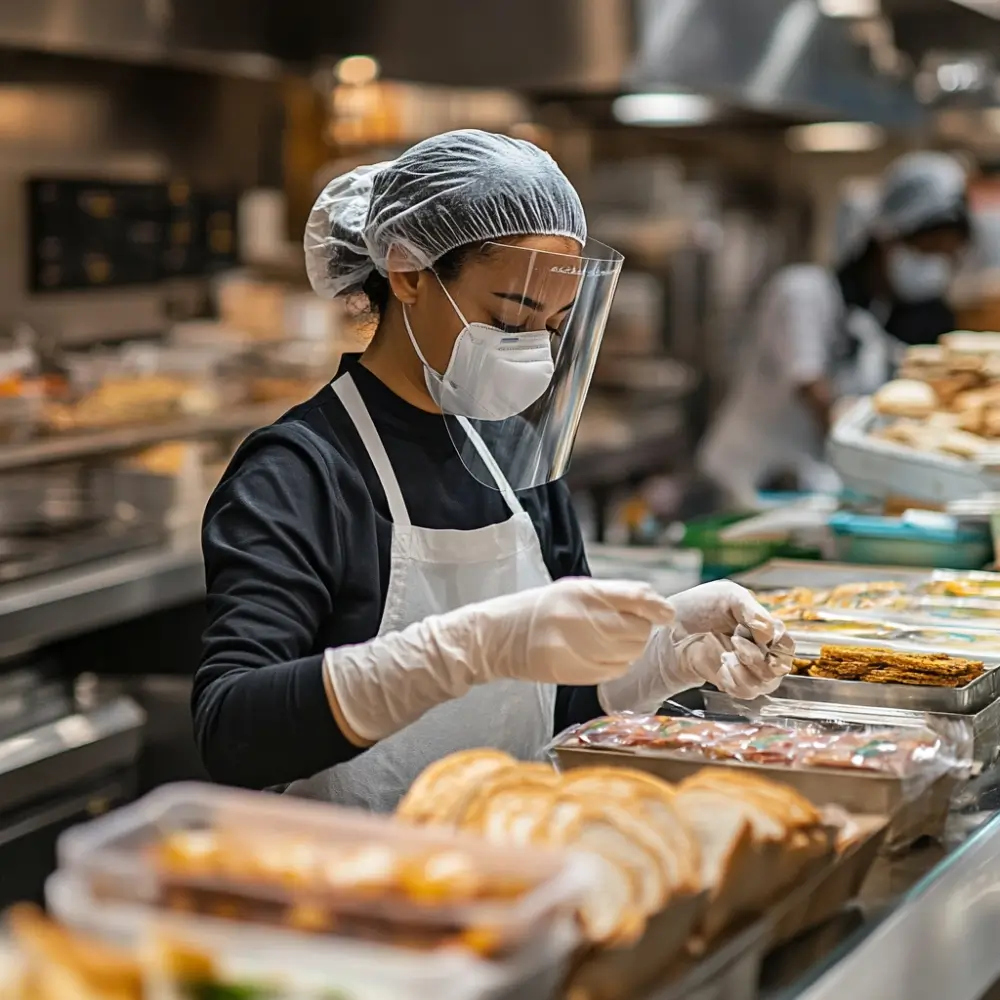In the bustling environment of the food industry, maintaining impeccable hygiene and ensuring worker safety are paramount. Personal Protective Equipment (PPE) serves as the frontline defense against contamination and workplace hazards, safeguarding both employees and the integrity of food products.
This comprehensive guide delves into the essential PPE gear for clean and safe operations in the food industry, providing insights into their importance, types, and best practices for effective usage.
Understanding PPE in the Food Industry
Personal Protective Equipment (PPE) in the food industry encompasses a range of gear designed to protect workers from physical, chemical, and biological hazards while ensuring that food products remain uncontaminated. From handling sharp tools and hot surfaces to preventing cross-contamination, PPE is indispensable in maintaining both workplace safety and food quality.
The Dual Role of PPE
PPE serves a dual purpose:
- Worker Protection: Shields employees from injuries, exposure to harmful substances, and occupational hazards.
- Food Safety: Prevents contamination from human sources, ensuring that food products meet hygiene standards.
Essential PPE Gear for Food Industry Workers
Ensuring the safety and hygiene of workers in the food industry is paramount not only for protecting employees but also for maintaining the integrity and quality of food products. Personal Protective Equipment (PPE) plays a crucial role in achieving these objectives. Below is a comprehensive overview of the essential PPE gear for food industry workers:
1. Gloves

Gloves create a barrier between workers’ hands and food, preventing the transfer of bacteria and contaminants.
Types:
- Nitrile Gloves: Durable and chemical-resistant, ideal for general food handling.
- Latex Gloves: Provide excellent elasticity but may cause allergic reactions in some individuals.
- Vinyl Gloves: Economical and suitable for short-term, low-risk tasks.
- Cut-Resistant Gloves: Essential for tasks involving sharp tools to prevent injuries.
Best Practices:
- Change gloves frequently, especially after handling raw and ready-to-eat foods.
- Avoid touching surfaces or other parts of the body while wearing gloves.
2. Hairnets and Beard Nets

Prevent hair from falling into food products, minimizing contamination risks.
Types:
- Standard Hairnets: Secure all types of hair, suitable for most food processing environments.
- Beard Nets: Designed for workers with facial hair, ensuring no hair particles contaminate the food.
Best Practices:
- Ensure complete coverage of hair and facial hair.
- Replace nets regularly to maintain hygiene.
3. Aprons and Gowns

Protect both the worker’s clothing and the food from cross-contamination.
Types:
- Disposable PE Aprons: Lightweight and ideal for short-duration tasks.
- Reusable Fabric Aprons: Durable and suitable for long-term use in environments with heavy contamination risks.
- Flame-Resistant Gowns: Essential in areas exposed to high heat.
Best Practices:
- Choose aprons based on the level of protection required.
- Regularly launder reusable aprons to maintain cleanliness.
4. Face Masks and Shields

Prevent respiratory droplets from contaminating food and protect the face from splashes.
Types:
- Disposable Face Masks: Suitable for general protection against droplets.
- FFP2 Respirators: Offer higher protection against airborne particles.
- Face Shields: Provide comprehensive protection for the eyes and face from splashes and debris.
Best Practices:
- Ensure masks fit snugly and do not interfere with movement.
- Clean and disinfect face shields regularly.
5. Safety Goggles

Protect workers’ eyes from chemical splashes and debris during food processing.
Types:
- Standard Safety Goggles: Offer basic eye protection.
- Chemical-Resistant Goggles: Essential when handling hazardous substances.
Best Practices:
- Choose goggles that fit comfortably and provide a clear field of vision.
- Replace damaged goggles immediately.
6. Hearing Protection

Protect workers’ hearing in environments with high noise levels from machinery.
Types:
- Earplugs: Inserted into the ear canal for noise reduction.
- Earmuffs: Cover the entire ear for comprehensive protection.
Best Practices:
- Select hearing protection based on noise exposure levels.
- Ensure proper fit to maximize effectiveness.
7. Steel-Toe Boots and Slip-Resistant Footwear

Protect workers’ feet from heavy objects and prevent slips in wet or greasy environments.
Features:
- Steel-Toe Boots: Offer protection against falling objects and punctures.
- Slip-Resistant Soles: Provide traction on slippery surfaces.
Best Practices:
- Choose footwear that complies with safety standards.
- Regularly inspect boots for wear and tear.
8. Cut-Resistant Gloves

Prevent cuts and injuries when handling sharp tools and machinery.
Types:
- Kevlar Gloves: Highly resistant to cuts and abrasions.
- Metal Mesh Gloves: Provide additional protection against punctures.
Best Practices:
- Use cut-resistant gloves for tasks involving knives and sharp equipment.
- Replace gloves once they show signs of damage.

Why PPE is Crucial in the Food Industry
Personal Protective Equipment (PPE) plays an indispensable role in the food industry, ensuring both employee safety and the integrity of food products. Here’s an in-depth look at why PPE is crucial in this sector:
1. Legal Requirements
In many regions, including the UK, PPE is a legal requirement outlined by the Health and Safety Executive (HSE) and the Food Standards Agency (FSA). Employers must provide suitable PPE and ensure workers are trained in its correct use.
Key Regulations:
- HSE Guidelines: Mandate PPE provision where risks cannot be mitigated by other means.
- FSA Guidance: Specific to food handlers to maintain hygiene and food safety standards.
- Food Safety Signs also play a critical role in reinforcing these guidelines, helping workers quickly identify potential hazards and hygiene protocols in food processing areas.
2. Protecting Kitchen Staff
Worker Safety: PPE shields employees from physical hazards like cuts and burns, as well as biological hazards such as bacteria and viruses.
Health Benefits:
- Reduces the risk of foodborne illnesses.
- Prevents workplace injuries, enhancing overall worker well-being.
3. Safeguarding Customers and Brand Reputation
Food Safety: Proper PPE usage ensures that food products remain uncontaminated, meeting hygiene standards and protecting consumers from potential illnesses.
Brand Trust: Visible use of PPE boosts consumer confidence in the safety and quality of the food, enhancing brand reputation and customer loyalty.

Best Practices for PPE Usage and Maintenance
Ensuring the effective use and maintenance of Personal Protective Equipment (PPE) is critical in the food industry to uphold safety standards, prevent contamination, and comply with regulatory requirements. Implementing best practices for PPE usage and maintenance not only protects employees but also maintains the integrity and quality of food products. Below are comprehensive best practices categorized into Usage, Maintenance, Training, and Storage.
Proper Selection
- Assess Risks: Conduct a thorough risk assessment to determine the appropriate PPE for each task.
- Quality Matters: Invest in high-quality PPE that meets industry standards and provides adequate protection.
Training and Compliance
- Employee Training: Ensure all workers are trained on the correct usage, maintenance, and disposal of PPE.
- Regular Audits: Conduct periodic checks to ensure compliance with PPE protocols and address any gaps.
Maintenance and Storage
- Cleanliness: Regularly clean reusable PPE according to manufacturer guidelines.
- Proper Storage: Store PPE in clean, dry areas to prevent contamination and damage.
Replacement
- Routine Checks: Inspect PPE regularly for signs of wear and tear.
- Immediate Replacement: Replace damaged or contaminated PPE promptly to maintain safety standards.
International Standards and Compliance
Adhering to international standards ensures consistency and reliability in PPE usage across global food industries. Key standards include:
- ISO 22000: Focuses on food safety management systems.
- EN 388: Specifies performance requirements for protective gloves.
- ANSI/ISEA Z87.1: Sets criteria for eye and face protection.
- HACCP: Provides guidelines for hazard analysis and critical control points in food safety.
Compliance Benefits:
- Ensures protection against global food safety hazards.
- Enhances credibility and trust with international partners and consumers.
Conclusion
Personal Protective Equipment is indispensable in the food industry, playing a critical role in maintaining hygiene, ensuring worker safety, and safeguarding product integrity. By selecting the right PPE, adhering to best practices, and complying with international standards, food industry businesses can create a secure and efficient working environment. Investing in quality PPE not only protects employees and consumers but also strengthens brand reputation and fosters long-term success.

